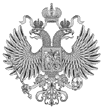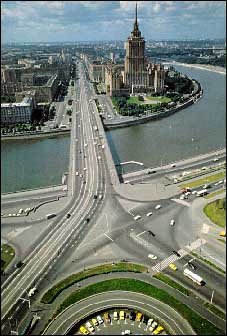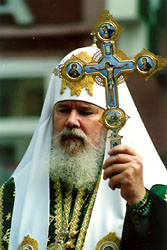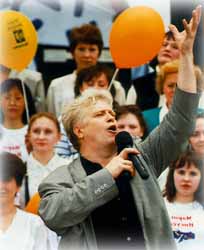Moscow area is the largest one in Russia in terms
of population and human resources.
POPULATION:
Around 12 ml. Majority are
Russians, but there are hundreds of thousands of other ethnic and racial
groups.
CAPITAL: 
Moscow is the most significant city in
Russia. Population (including foreigners) exceeds 13 ml. There are
hundreds of cities, towns and villages around Moscow. Majority of
people from there work in Moscow and travel daily on electric trains to
their jobs.
ECONOMY: 
Moscow is still suffering an economical turmoil
as well as the Russian Federation in general. It is obviously
observed in economy, politics and religious life.
The economic situation is critical due to the following reasons:
 unreasonable financial policy bringing budget deficit to the state and
abnormal loans from the West countries;
unreasonable financial policy bringing budget deficit to the state and
abnormal loans from the West countries;
 instability
in the government. V. Putin became a new head of the government in the
beginning of August 1999. The previous government existed just 3 months.
The inflation is going on. instability
in the government. V. Putin became a new head of the government in the
beginning of August 1999. The previous government existed just 3 months.
The inflation is going on.
 a high
number of budgetary institutions (most of schools, universities,
hospitals, libraries, theaters, museums, army and e.g.). a high
number of budgetary institutions (most of schools, universities,
hospitals, libraries, theaters, museums, army and e.g.).
All these factors result into a situation in which
millions of
budgetary employees are not paid for several months. Even those who have
a stable income receive an average salary of no more then US $150-200 a
month. The economic situation influences different layers of population
but children, pensioners and unemployed people suffer most of all. At
the same time, there is a prosperous class of Muscovites (so called
"New Russians") who can afford to buy very expensive
apartments and cars. Their wealth in many cases derives from the illegal
business, operations with former state property and from dealings with
the Mafia.
BRIEF SURVEY OF THE ECONOMIC CRISIS IN AUGUST
1998
The Russian government is maintaining the
following financial policy:
 keeping the
budget stable; keeping the
budget stable;
 avoiding
inflation by any means ; avoiding
inflation by any means ;
 trying to
maintain a fixed ruble/dollar rate. trying to
maintain a fixed ruble/dollar rate.
These measures do not resolve problems of average Russian people. It
is more like just a good-looking theory, which is not effective in
practice.
To accomplish the above goals the government used its own resources plus
loans from the Western countries. Finally, when these resources were
exhausted and inflation could not be restrained any longer, the ruble
rate was "set free" according to its real market value. During
only 10 days of August 1998 the ruble fell down for almost 100% and till
the end of 1998 the inflation rate was 300%. A very unscrupulous
governmental policy was demonstrated in the GKO pyramid. It was a method
to take finances out of banks and investment companies that finally was
one of the reasons of collapse and bankruptcy of such.
The population rushed to the banks to save their savings. It is well
known that if the majority of bank's clients withdraw their savings
concurrently, the bank may easily become a bankrupt. This happened to
the number of Russian banks both large and medium within one-week term.
Because of that, the army of unemployed people has multiplied.
I want to draw a parallel between situation in Russia today and
situation in the States in 1927-1929. The President Hoover tried to
resolve similar problems using similar methods. Yet, his policy was one
of the reasons of the Great Depression, which struck America.
Truly, God gave wisdom to the next American president, Franklin
Roosevelt, enabling him to lead America out of economic chaos of 30's.
Today in Russia, we desperately need government that will be God's given
and which will have wisdom and compassion on people as president
Roosevelt had.
RELIGION:
Russia is a secular
country
without state religion, though the influence of Russian Orthodox Church
is growing rapidly. According to statistics the population in Moscow can
be approximately considered as: Russian Orthodox church - about 45%,
Catholic church - 1%, Protestant denominations - 1%, Atheists and
Agnostics groups - near 40%.
Those figures are not absolutely accurate as many people claim that they
are Orthodox simply because they occasionally visit the Orthodox
cathedrals, or think that Russians are historically (or automatically)
belong to Orthodox, or they think that to be an Orthodox is just a
modern fashion which is nice to follow.
RUSSIAN ORTHODOX CHURCH 
This is the largest religious
institution in Russia. Hundreds of thousands of adult people received a
water baptism in Orthodox church, although it is necessary to note, that
the baptism was a sign of national belonging for many of them, rather
than an expression of devotion to real faith. Unfortunately, the Gospel
is not preached in most of the Orthodox churches and for many people it
is nothing more than mere sacred mystery with lot of icons, candles,
memorized prayers (many of them to Mary and the saints).
In many aspects the situation in the Russian Orthodox Church today can
be compared to the Catholic Church of a century ago.
PROTESTANT CHURCHES 
Russian Orthodox Church used to
be a leading church in the state for many centuries. Nowadays, there are
forces that desire to return this status.
In October 1997 the law "On Freedom of Conscience and Religious
Associations" was signed by president Yeltsin. This law enables the
local authorities (absolute majority of them are pro-Orthodox) to
control religious organizations. This resulted to evictions of some
Protestant churches from buildings rented for meetings in many towns,
including Moscow region. This situation causes many problems, as the
majority of churches don't have finances to purchase or build their own
facilities. Even now, many churches of evangelical faith hold the church
services outdoors or shrinking in the little apartments of the believers.
In general, Russian Protestant church is young, persecuted but growing.



|
